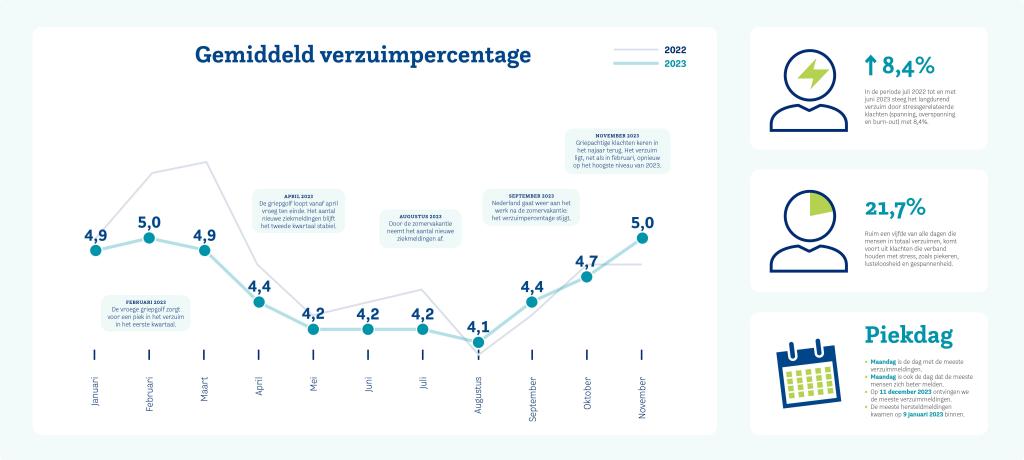Absenteeism in 2023: flu and stress-related issues biggest cause of absenteeism

Absenteeism in November again at the highest level
The rise of the average absenteeism in November is particularly caused by flu-like symptoms. This seems to be continuing in December. For each 1,000 employees, there were 83 new reported absences in November (compared with 72 in October 2023). The high number of reported absences was particularly notable in education: 136 new reported absences per 1,000 employees. Although the rise in absenteeism is usual for this time of year, it seems to have started earlier than in 2022.
Annual trends in absenteeism
From December 2022 to November 2023, the average absenteeism of 4.6% was lower than in the previous year (4.7%). In contrast to the usual seasonal pattern, the annual absence trend has been strongly influenced by Covid over the past three years. In 2023, the health and safety services have seen the seasonal trends in absenteeism reappearing. 'People have reported ill less often in 2023 than in 2022,' says Redmer van Wijngaarden, director of medical affairs at ArboNed. 'At the same time, we see that the rising trend in long-term absenteeism due to mental health issues has continued. Furthermore, the seasonal peaks in absenteeism caused by flu-like symptoms create challenges for employers in what is still a tight labour market.'
Prevent absenteeism due to mental illness
For the New Year, ArboNed and HumanCapitalCare are particularly continuing to focus on mental health-related absenteeism as an important point for attention. In the period July 2022 through June 2023, there was an 8.4% increase in long-term absenteeism caused by stress-related issues (stress, nervous exhaustion and burn-out). Over a fifth of the total number of days on which people are absent is due to issues related to stress, such as worrying, lethargy and tension. Particular sectors affected were public administration, healthcare and education.
Balance
Although stress-related symptoms can often lead to employees failing to turn up at work, company doctors at ArboNed and HumanCapitalCare say that in 40% of cases the causes have little to do with the work itself. Events in someone's personal life, such as informal care, divorce or financial worries, can have a big impact on performance at work. Van Wijngaarden emphasises the importance of a personal approach: 'Mental health issues mean that more and more people are absent for a long period. In many cases, this could have been prevented with appropriate and timely support. It is important that employers and employees continue talking to each other and where possible take timely action to maintain a good balance.'
Summary absenteeism in 2023
1st quarter
The early flu epidemic causes a 5.0% peak in absenteeism in February. Although the average absenteeism rate in March fell to 4.9%, absenteeism was still substantially higher than before the 2019 COVID pandemic (4.5% in March 2019).
2nd quarter
In the second quarter of 2023, absenteeism fell further: from 4.4% in April to 4.2% in May and June. In particular, the healthcare sector saw a decline in the number of reported absences. The average number of reported absences remained stable in this quarter because of the early end to the flu epidemic in April.
3rd quarter
In the summer holiday, ArboNed and HumanCapitalCare received fewer reports of absences than usual in this period. The average absenteeism rate in the Netherlands fell to 4.1% in August but rose to 4.4% in September (again reflecting the seasonal trend). For many employees, that first day of work after a period of relaxation during the summer holiday brings an ‘after-holiday dip’.
4th quarter
In the final quarter of the year, flu-like symptoms reappear, causing a rise in the average absenteeism rate to 4.7% in October and 5.0% in November. Education is hit particularly hard.